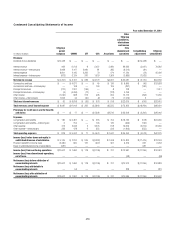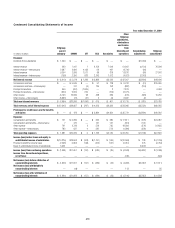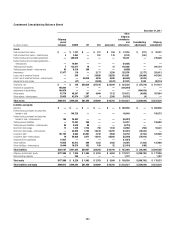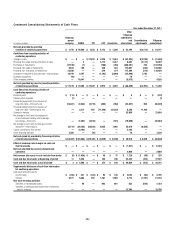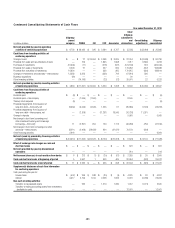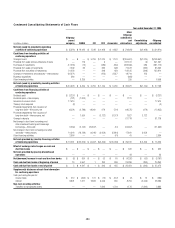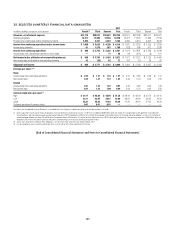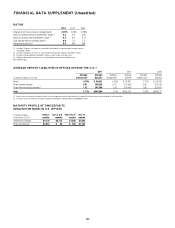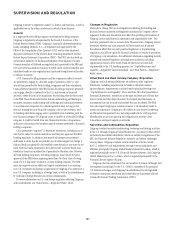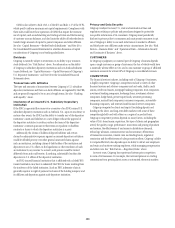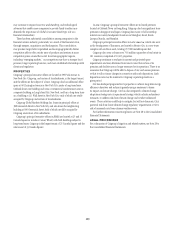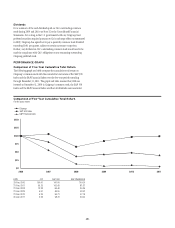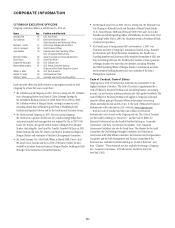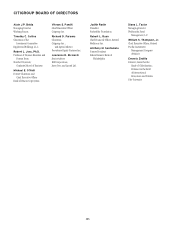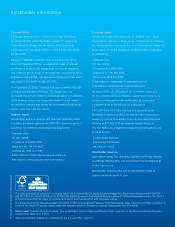Citibank 2011 Annual Report Download - page 310
Download and view the complete annual report
Please find page 310 of the 2011 Citibank annual report below. You can navigate through the pages in the report by either clicking on the pages listed below, or by using the keyword search tool below to find specific information within the annual report.288
CGMI is also subject to Rule 15c3-1 of the SEC and Rule 1.17 of the CTFC,
which specify uniform minimum net capital requirements. Compliance with
these rules could limit those operations of CGMI that require the intensive
use of capital, such as underwriting and trading activities and the financing
of customer account balances, and also limits the ability of broker-dealers to
transfer large amounts of capital to parent companies and other affiliates.
See also “Capital Resources—Broker-Dealer Subsidiaries” and Note 20 to
the Consolidated Financial Statements for a further discussion of capital
considerations of Citigroup’s non-banking subsidiaries.
Dividends
Citigroup is currently subject to restrictions on its ability to pay common
stock dividends. See “Risk Factors” above. For information on the ability
of Citigroup’s subsidiary depository institutions and non-bank subsidiaries
to pay dividends, see “Capital Resources—Capital Resources of Citigroup’s
U.S. Depository Institutions” and Note 20 to the Consolidated Financial
Statements above.
Transactions with Affiliates
The types and amounts of transactions between Citigroup’s U.S. subsidiary
depository institutions and their non-bank affiliates are regulated by the FRB,
and are generally required to be on arm’s-length terms. See also “Funding
and Liquidity” above.
Insolvency of an Insured U.S. Subsidiary Depository
Institution
If the FDIC is appointed the conservator or receiver of an FDIC-insured U.S.
subsidiary depository institution such as Citibank, N.A., upon its insolvency or
certain other events, the FDIC has the ability to transfer any of the depository
institution’s assets and liabilities to a new obligor without the approval of
the depository institution’s creditors, enforce the terms of the depository
institution’s contracts pursuant to their terms or repudiate or disaffirm
contracts or leases to which the depository institution is a party.
Additionally, the claims of holders of deposit liabilities and certain
claims for administrative expenses against an insured depository institution
would be afforded priority over other general unsecured claims against
such an institution, including claims of debt holders of the institution and
depositors in non-U.S. offices, in the liquidation or other resolution of such
an institution by any receiver. As a result, such persons would be treated
differently from and could receive, if anything, substantially less than the
depositors in U.S. offices of the depository institution.
An FDIC-insured financial institution that is affiliated with a failed FDIC-
insured institution may have to indemnify the FDIC for losses resulting from
the insolvency of the failed institution. Such an FDIC indemnity claim is
generally superior in right of payment to claims of the holding company and
its affiliates and depositors against such depository institution.
Privacy and Data Security
Citigroup is subject to many U.S., state and international laws and
regulations relating to policies and procedures designed to protect the
non-public information of its consumers. Citigroup must periodically
disclose its privacy policy to consumers and must permit consumers to opt
out of Citigroup’s ability to use such information to market to affiliates
and third-party non-affiliates under certain circumstances. See also “Risk
Factors—Business Risks” and “Operational Risk—Information Security
and Continuity of Business” above.
CUSTOMERS
In Citigroup’s judgment, no material part of Citigroup’s business depends
upon a single customer or group of customers, the loss of which would have
a materially adverse effect on Citi, and no one customer or group of affiliated
customers accounts for at least 10% of Citigroup’s consolidated revenues.
COMPETITION
The financial services industry, including each of Citigroup’s businesses,
is highly competitive. Citigroup’s competitors include a variety of other
financial services and advisory companies such as banks, thrifts, credit
unions, credit card issuers, mortgage banking companies, trust companies,
investment banking companies, brokerage firms, investment advisory
companies, hedge funds, private equity funds, securities processing
companies, mutual fund companies, insurance companies, automobile
financing companies, and internet-based financial services companies.
Citigroup competes for clients and capital (including deposits and
funding in the short- and long-term debt markets) with some of these
competitors globally and with others on a regional or product basis.
Citigroup’s competitive position depends on many factors, including the
value of Citi’s brand name, reputation, the types of clients and geographies
served, the quality, range, performance, innovation and pricing of products
and services, the effectiveness of and access to distribution channels,
technology advances, customer service and convenience, effectiveness
of transaction execution, interest rates and lending limits, regulatory
constraints and the effectiveness of sales promotion efforts. Citigroup’s ability
to compete effectively also depends upon its ability to attract new employees
and retain and motivate existing employees, while managing compensation
and other costs. See “Risk Factors—Regulatory Risks” above.
In recent years, Citigroup has experienced intense price competition
in some of its businesses. For example, the increased pressure on trading
commissions from growing direct access to automated, electronic markets


